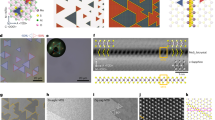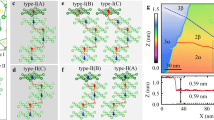Abstract
We provide direct evidence for the existence of isolated, one-dimensional charge density waves at mirror twin boundaries (MTBs) of single-layer semiconducting MoSe2. Such MTBs have been previously observed by transmission electron microscopy and have been predicted to be metallic in MoSe2 and MoS21,2,3,4,5,6,7. Our low-temperature scanning tunnelling microscopy/spectroscopy measurements revealed a substantial bandgap of 100 meV opening at the Fermi energy in the otherwise metallic one-dimensional structures. We found a periodic modulation in the density of states along the MTB, with a wavelength of approximately three lattice constants. In addition to mapping the energy-dependent density of states, we determined the atomic structure and bonding of the MTB through simultaneous high-resolution non-contact atomic force microscopy. Density functional theory calculations based on the observed structure reproduced both the gap opening and the spatially resolved density of states.
This is a preview of subscription content, access via your institution
Access options
Subscribe to this journal
Receive 12 print issues and online access
$259.00 per year
only $21.58 per issue
Buy this article
- Purchase on SpringerLink
- Instant access to full article PDF
Prices may be subject to local taxes which are calculated during checkout




Similar content being viewed by others
References
van der Zande, A. M. et al. Grains and grain boundaries in highly crystalline monolayer molybdenum disulphide. Nature Mater. 12, 554–561 (2013).
Lehtinen, O. et al. Atomic scale microstructure and properties of Se-deficient two-dimensional MoSe2 . ACS Nano 9, 3274–3283 (2015).
Zou, X., Liu, Y. & Yakobson, B. I. Predicting dislocations and grain boundaries in two-dimensional metal-disulfides from the first principles. Nano Lett. 13, 253–258 (2013).
Zhou, W. et al. Intrinsic structural defects in monolayer molybdenum disulfide. Nano Lett. 13, 2615–2622 (2013).
Liu, H. et al. Dense network of one-dimensional midgap metallic modes in monolayer MoSe2 and their spatial undulations. Phys. Rev. Lett. 113, 066105 (2014).
Gibertini, M. & Marzari, N. Emergence of one-dimensional wires of free carriers in transition-metal-dichalcogenide nanostructures. Nano Lett. 15, 6229–6238 (2015).
Le, D. & Rahman, T. S. Joined edges in MoS2: metallic and half-metallic wires. J. Phys. Condens. Matter 25, 312201 (2013).
Lahiri, J. et al. An extended defect in graphene as a metallic wire. Nature Nanotech. 5, 326–329 (2010).
Yazyev, O. V. & Louie, S. G. Electronic transport in polycrystalline graphene. Nature Mater. 9, 806–809 (2010).
Ugeda, M. M., Brihuega, I., Guinea, F. & Gómez-Rodríguez, J. M. Missing atom as a source of carbon magnetism. Phys. Rev. Lett. 104, 096804 (2010).
Tsen, A. W. et al. Tailoring electrical transport across grain boundaries in polycrystalline graphene. Science 336, 1143–1146 (2012).
López-Polín, G. et al. Increasing the elastic modulus of graphene by controlled defect creation. Nature Phys. 11, 26–31 (2015).
Mak, K. F., Lee, C., Hone, J., Shan, J. & Heinz, T. F. Atomically thin MoS2: a new direct-gap semiconductor. Phys. Rev. Lett. 105, 136805 (2010).
Splendiani, A. et al. Emerging photoluminescence in monolayer MoS2 . Nano Lett. 10, 1271–1275 (2010).
Zhang, Y. et al. Direct observation of the transition from indirect to direct bandgap in atomically thin epitaxial MoSe2 . Nature Nanotech. 9, 111–115 (2014).
Baugher, B. W. H., Churchill, H. O. H., Yang, Y. & Jarillo-Herrero, P. Intrinsic electronic transport properties of high-quality monolayer and bilayer MoS2 . Nano Lett. 13, 4212–4216 (2013).
Kang, K. et al. High-mobility three-atom-thick semiconducting films with wafer-scale homogeneity. Nature 520, 656–660 (2015).
Qiu, D. Y., da Jornada, F. H. & Louie, S. G. Optical spectrum of MoS2: many-body effects and diversity of exciton states. Phys. Rev. Lett. 111, 216805 (2013).
Bernardi, M., Palummo, M. & Grossman, J. C. Extraordinary sunlight absorption and one nanometer thick photovoltaics using two-dimensional monolayer materials. Nano Lett. 13, 3664–3670 (2013).
Britnell, L. et al. Strong light–matter interactions in heterostructures of atomically thin films. Science 340, 1311–1314 (2013).
Ugeda, M. M. et al. Giant bandgap renormalization and excitonic effects in a monolayer transition metal dichalcogenide semiconductor. Nature Mater. 13, 1091–1095 (2014).
Geim, A. K. & Grigorieva, I. V. Van der Waals heterostructures. Nature 499, 419–425 (2013).
Lee, C.-H. et al. Atomically thin p–n junctions with van der Waals heterointerfaces. Nature Nanotech. 9, 676–681 (2014).
Qiu, H. et al. Hopping transport through defect-induced localized states in molybdenum disulphide. Nature Commun. 4, 2642 (2013).
Cai, L. et al. Vacancy-induced ferromagnetism of MoS2 nanosheets. J. Am. Chem. Soc. 137, 2622–2627 (2015).
Bao, W. et al. Visualizing nanoscale excitonic relaxation properties of disordered edges and grain boundaries in monolayer molybdenum disulfide. Nature Commun. 6, 7993 (2015).
Zhang, Z., Zou, X., Crespi, V. H. & Yakobson, B. I. Intrinsic magnetism of grain boundaries in two-dimensional metal dichalcogenides. ACS Nano 7, 10475–10481 (2013).
Lauritsen, J. V. et al. Hydrodesulfurization reaction pathways on MoS2 nanoclusters revealed by scanning tunneling microscopy. J. Catal. 224, 94–106 (2004).
Jaramillo, T. F. et al. Identification of active edge sites for electrochemical H2 evolution from MoS2 nanocatalysts. Science 317, 100–102 (2007).
Grüner, G. Density Waves in Solids (Perseus, 2000).
Peierls, R. E. Quantum Theory of Solids (Oxford Univ. Press, 1955).
Peng, J.-P. et al. Molecular beam epitaxy growth and scanning tunneling microscopy study of TiSe2 ultrathin films. Phys. Rev. B 91, 121113 (2015).
Ugeda, M. M. et al. Characterization of collective ground states in single-layer NbSe2 . Nature Phys. 12, 92–97 (2016).
Heeger, A. J., Kivelson, S., Schrieffer, J. R. & Su, W.-P. Solitons in conducting polymers. Rev. Mod. Phys. 60, 781–850 (1988).
Yeom, H. W. et al. Instability and charge density wave of metallic quantum chains on a silicon surface. Phys. Rev. Lett. 82, 4898–4901 (1999).
Jérome, D. Organic conductors: from charge density wave TTF-TCNQ to superconducting (TMTSF)2PF6 . Chem. Rev. 104, 5565–5591 (2004).
Shin, J. S., Ryang, K.-D. & Yeom, H. W. Finite-length charge-density waves on terminated atomic wires. Phys. Rev. B 85, 073401 (2012).
Cheon, S., Kim, T.-H., Lee, S.-H. & Yeom, H. W. Chiral solitons in a coupled double Peierls chain. Science 350, 182–185 (2015).
Murata, H. & Koma, A. Modulated STM images of ultrathin MoSe2 films grown on MoS2(0001) studied by STM/STS. Phys. Rev. B 59, 10327–10334 (1999).
Gross, L., Mohn, F., Moll, N., Liljeroth, P. & Meyer, G. The chemical structure of a molecule resolved by atomic force microscopy. Science 325, 1110–1114 (2009).
Hapala, P. et al. Mechanism of high-resolution STM/AFM imaging with functionalized tips. Phys. Rev. B 90, 085421 (2014).
Perdew, J. P., Burke, K. & Ernzerhof, M. Generalized gradient approximation made simple. Phys. Rev. Lett. 77, 3865–3868 (1996).
Grüner, G. The dynamics of charge-density waves. Rev. Mod. Phys. 60, 1129–1181 (1988).
Horcas, I. et al. WSXM: a software for scanning probe microscopy and a tool for nanotechnology. Rev. Sci. Instrum. 78, 013705 (2007).
Kresse, G. & Furthmüller, J. Efficient iterative schemes for ab initio total-energy calculations using a plane-wave basis set. Phys. Rev. B 54, 11169–11186 (1996).
Acknowledgements
We acknowledge P. Hapala for assistance with the nc-AFM image simulations. We thank our colleagues at the Molecular Foundry for stimulating discussion and assistance. Work at the Molecular Foundry was supported by the Office of Science, Office of Basic Energy Sciences, of the US Department of Energy under Contract No. DE-AC02-05CH11231 (user proposal #3282) (STM imaging, STM spectroscopy, theoretical simulations, and analysis). A.W.-B. and S.W. were supported by the US Department of Energy, Office of Science, Basic Energy Sciences, Scientific User Facilities Division (NSRCs) Early Career Award. S.B. acknowledges fellowship support by the European Union under FP7-PEOPLE-2012-IOF-327581. ALS and SIMES were supported by Office of Basic Energy Science, US DOE, under contract numbers DE-AC02-05CH11231 and DE-AC02-76SF00515, respectively. H.R. acknowledges support from the Max Planck Korea/POSTECH Research Initiative of the NRF under Project No. NRF-2011-0031558. M.B.S. was supported by the Division of Materials Science and Engineering through the Chemical and Mechanical Properties of Surfaces and Interfaces Program. Portions of the computational work were done with NERSC resources. M.F.C. acknowledges support from National Science Foundation grant EFMA-1542741 (sample surface preparation development).
Author information
Authors and Affiliations
Contributions
S.B., S.W. and A.W.-B. conceived the work and designed the research strategy. S.B. and S.W. measured and analysed the STM/STS and nc-AFM data. Z.-F.L. performed the theoretical calculations. Y.Z. and H.R. performed the MBE growth and characterization of the samples. S.-K.M., Z.H. and Z.-X.S. supervised the MBE growth and sample characterization. J.B.N. supervised the theoretical calculations. M.M.U., E.W., M.B.S., F.W., M.F.C. and D.F.O. participated in the acquisition and interpretation of the experimental data. A.W.-B. supervised the STM/STS and nc-AFM measurements. S.B. wrote the manuscript with help from S.W., Z.-F.L., D.F.O., J.B.N. and A.W.-B. All authors contributed to the scientific discussion and manuscript revisions.
Corresponding authors
Ethics declarations
Competing interests
The authors declare no competing financial interests.
Supplementary information
Supplementary information
Supplementary information (PDF 2474 kb)
Rights and permissions
About this article
Cite this article
Barja, S., Wickenburg, S., Liu, ZF. et al. Charge density wave order in 1D mirror twin boundaries of single-layer MoSe2. Nature Phys 12, 751–756 (2016). https://doi.org/10.1038/nphys3730
Received:
Accepted:
Published:
Issue date:
DOI: https://doi.org/10.1038/nphys3730
This article is cited by
-
Integrated 1D epitaxial mirror twin boundaries for ultrascaled 2D MoS2 field-effect transistors
Nature Nanotechnology (2024)
-
Modulated Kondo screening along magnetic mirror twin boundaries in monolayer MoS2
Nature Physics (2024)
-
Artificial kagome lattices of Shockley surface states patterned by halogen hydrogen-bonded organic frameworks
Nature Communications (2024)
-
Giant intrinsic photovoltaic effect in one-dimensional van der Waals grain boundaries
Nature Communications (2024)
-
Recent progress in the role of grain boundaries in two-dimensional transition metal dichalcogenides studied using scanning tunneling microscopy/spectroscopy
Applied Microscopy (2023)



